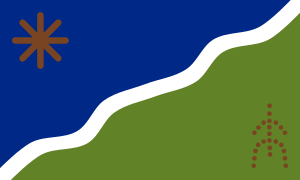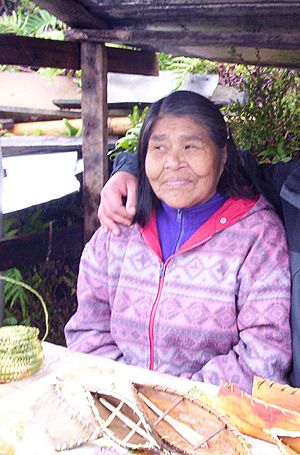Kawésqar facts for kids

Flag
|
|
| Total population | |
|---|---|
| 3,448 (2017) | |
| Regions with significant populations | |
| Chile: Puerto Edén | |
| Languages | |
| Spanish, Kawésqar | |
| Religion | |
| Traditional tribal religion, Christian (mostly Protestant) | |
| Related ethnic groups | |
| Yaghan |
The Kawésqar are an indigenous group from Chile. They are also known as the Alacalufe. They live in Chilean Patagonia, on islands near the Strait of Magellan. Their language, Kawésqar, is endangered, meaning very few people still speak it.
Contents
Understanding the Kawésqar Name
The name Alacaluf was first used by Europeans. They heard it from the Yaghan people, another indigenous group. In the Yaghan language, "Alacaluf" means "mussel eater."
However, the Kawésqar people call themselves Kawésqar. This is their own name for their group.
How the Kawésqar Lived
The Kawésqar were a nomadic people. This means they did not stay in one place. They were known as "canoe-people" because they traveled a lot by water.
They made long canoes, about eight to nine meters (26-30 feet) long. These canoes were wide enough for a whole family and their dog. The Kawésqar used these canoes for fishing and moving around. They lived this way until the 1900s. Then, they started to live in settled communities on land. Because they lived on the water, the Kawésqar never farmed the land.
Kawésqar Population Changes
It is thought that the Kawésqar population was never more than 5,000 people. They lived in a large area, from the Gulf of Penas in the north to the Brecknock Peninsula in the south.
Like many other indigenous groups, the Kawésqar faced big challenges. When Europeans came to their lands in the late 1880s, the Kawésqar suffered from new diseases. These diseases were common in Europe but new and dangerous to the Kawésqar. Their way of life also changed a lot.
In the 1930s, many Kawésqar were moved to Wellington Island. They settled in a town called Puerto Edén. This was done to protect them from the changes happening around them. Later, some moved even further south, to Puerto Natales and Punta Arenas.
Today, there are not many Kawésqar left. In 2002, about 2,622 people identified as Kawésqar. This meant they still followed their culture or spoke their language. By 2006, only about 15 people were considered full-blooded Kawésqar. However, many people with mixed backgrounds have Kawésqar family roots.
Lessons in the Kawésqar language are now taught in local schools. But it is hard to keep the language alive when few people speak it every day. In 2021, a Kawésqar activist named Margarita Vargas López was chosen to represent her people. She joined the Chilean Constitutional Convention.
Kawésqar Groups and Language
Some of the different Kawésqar groups included Adwipliin, Aksánas, Alacaluf, Cálen, Caucahué, Enoo, Lecheyel, Taíjataf, and Yequinahuere.
In 1884, Thomas Bridges and his son Despard created a list of 1,200 words for the Kawésqar language. Thomas Bridges was a missionary who had been working with indigenous people in Tierra del Fuego. Many missionaries and scientists later studied and helped the Kawésqar people.
Kawésqar in Exhibitions
In 1881, some people from Europe took eleven Kawésqar people from Patagonia. They were taken to be shown in exhibitions in Paris and the Berlin Zoological Garden. Sadly, only four of them survived and returned to Chile.
In 2010, the remains of five of the seven people who died in Europe were returned to Chile. These remains had been kept at the University of Zurich in Switzerland for studies. When the remains came back, the president of Chile formally apologized. He said sorry for the government allowing these indigenous people to be taken from their home and treated like animals.
See also
 In Spanish: Kawésqar para niños
In Spanish: Kawésqar para niños



